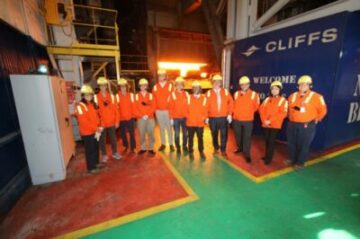Sign up for daily news updates from CleanTechnica on email. Or follow us on Google News!
Sun Bear, an enormous solar and battery storage installation in the Four Corners region of Colorado, will have more than two million solar panels spread across 5,500 acres of land belonging to the Ute Mountain Ute Tribe, part of the Weenuche Band of the Ute Nation. The primary developer is the Canigou Group, which styles itself as a global leader in renewable energy. “We are active throughout Europe, Australia and North America where we work with partners at the local level to provide a holistic solution,” it says on its website. The Sun Bear facility will cost up to $1.5 billion and produce peak power of 975 MW. There is no information currently available about the size of the battery storage system or who will supply the batteries for it.
There are several reasons why the site in southwest Colorado, which borders New Mexico, Arizona, and Utah, was chosen for this large scale solar project. Carigou Group says “Sun Bear is well positioned for harnessing the sun with its large unobstructed sky, high annual solar irradiance, and low seasonal variability. The site is located close to a confluence of transmission systems which provide access to customers via both transmission and distribution interconnection.”
All those factors are significant. An unobstructed sky means no shading issues that might reduce the amount of electricity that can be produced. High solar irradiance is a fancy way of saying the area gets a lot of sunlight throughout the year. Low seasonal variability means the output of the Sun Bear solar farm will not vary appreciably with the seasons. Proximity to existing transmission lines for the Western Area Power Administration means the developer will not need to build long and expensive new transmission infrastructure to connect the solar farm to the grid.
According to KSUT News, an NPR affiliate, it is unclear what regional entities Canigou will sell the electricity to. “We’re thinking about the power needs within Colorado,” said Justin Passfield of Carigou Group. “But also, it makes sense not to transmit power too far from where you are. Having said that, we’re going to be producing a large amount of power. So I’m not sure that all of it will be able to be consumed within Colorado.” The Indigenous community will receive a percentage of the revenue generated by solar energy to help fund Ute Mountain Ute programs, develop jobs, and increase educational opportunities.
Sun Bear Benefits The Local Community
Members of the Tribe can also expect to find employment during the construction phase of the Sun Bear solar farm, which will need between 500 and 1000 workers to complete the project. Construction will begin in 2024 and the facility is expected to begin operations in 2026. Ute Mountain Ute chairman Manuel Heart says he is excited about the job opportunities tribal members and the opportunity for the tribe to become a significant player in renewable energy.
“We, as the Ute Mountain Ute tribe, had been a fossil fuel tribe with oil and gas for a long time, probably over 50 years. Today, with the changes in legislation, global warming, and climate change, you can see the impact of what’s happening to our world. So renewable is the new future right now,” said Heart.
Carigou Group contracted with RICK Engineering to help plan the Sun Bear solar installation. Its team created a 3D model for the conceptual design of the solar farm and the surrounding area in Colorado’s Four Corners region, and played a major a role in presenting this model to the local community. That 3D model was used extensively during consultations with Tribal leaders.
While attending community meetings to show the tribe and surrounding community what the project will look like, the Tribal Chairman and Carigou Group representatives asked Team RICK to move the model around and show views from the homes of different tribal members in attendance at the meeting. This very detailed model enabled them to show what will be visible from different locations. RICK has also created a video from the model which shows what impact the solar farm will have to people passing through the area. This tool has been very beneficial in helping the community visualize how the Sun Bear solar farm will affect their lives.
[embedded content]
A Collaboration With The Community
“Working on the Sun Bear Solar Farm project has been a fantastic experience for the Arvada Design Team. Not only is it another opportunity to showcase our graphic and technical capabilities, but it also allows us to build a good relationship with the Ute Mountain Ute Tribe and continue RICK’s involvement in the renewable energy market,” said Mike While, an associate principal for the company.
Jared Gorby, the principal landscape and urban designer for RICK Engineering, said, “I had the privilege of assembling the solar farm 3D model and presenting it to the tribal members and residents. This is our largest 3D model so far at around 775 square miles, so showing such a large model in real time presented a unique challenge. Thanks to the knowledge and ability of our amazing IT staff and engineers, we were able to pull it off.
“It is also an honor to work with and learn from the Ute Mountain Ute Tribal Council Chairman Manuel Heart. I look forward to seeing the positive impacts of the project come to fruition for the tribe, while also reducing the area’s dependence on fossil fuels.” Sun Bear is expected to avoid nearly 1.5 million tons of carbon dioxide emissions annually during its planned 35-year life span.
“The Ute Mountain Ute Tribe is one of our primary partners, and Sun Bear would not be successful without their vision and participation. We respect the work they have done around clean energy in the past, the generational knowledge of the land, and all that they bring to project Sun Bear,” says Carigou Group.
The Takeaway
Sun Bear shows how people working together can create new opportunities for renewable energy that benefit the local community as well as those who live further away. The electricity generated by Sun Bear will be enough to power 250,000 homes. Fossil fuel companies are used to bringing their enormous drilling rigs in and pounding the Earth into submission, but renewable energy initiatives have to be careful to preserve the environment. In terms of impacts on the land during construction, local plant life and wildlife such as the Mesa Verde cactus and the burrowing owl will have specified no-construction buffers surrounding each cactus and active nest.
Sun Bear is an example of solar done right, a partnership that merges the interests of a diverse group of people to produce a renewable energy facility that benefits all. At a time when renewable energy is getting enormous pushback from well funded fossil fuel groups, Carigou Group, RICK Engineering, and the Ute Mountain Ute Tribe are proving we can all work together to take a step forward on the path to a low carbon future.
Have a tip for CleanTechnica? Want to advertise? Want to suggest a guest for our CleanTech Talk podcast? Contact us here.
Latest CleanTechnica TV Video
[embedded content]
I don’t like paywalls. You don’t like paywalls. Who likes paywalls? Here at CleanTechnica, we implemented a limited paywall for a while, but it always felt wrong — and it was always tough to decide what we should put behind there. In theory, your most exclusive and best content goes behind a paywall. But then fewer people read it!! So, we’ve decided to completely nix paywalls here at CleanTechnica. But…
Thank you!
Advertisement
CleanTechnica uses affiliate links. See our policy here.
- SEO Powered Content & PR Distribution. Get Amplified Today.
- PlatoData.Network Vertical Generative Ai. Empower Yourself. Access Here.
- PlatoAiStream. Web3 Intelligence. Knowledge Amplified. Access Here.
- PlatoESG. Carbon, CleanTech, Energy, Environment, Solar, Waste Management. Access Here.
- PlatoHealth. Biotech and Clinical Trials Intelligence. Access Here.
- Source: https://cleantechnica.com/2024/02/18/sun-bear-solar-farm-will-be-eight-miles-long-one-mile-wide-and-have-two-million-solar-panels/
- :has
- :is
- :not
- :where
- $UP
- 000
- 1
- 15%
- 2024
- 2026
- 250
- 36
- 3d
- 5
- 50
- 50 Years
- 500
- 775
- 800
- a
- ability
- Able
- About
- access
- acres
- across
- active
- administration
- Advertise
- affect
- Affiliate
- All
- allows
- also
- always
- amazing
- america
- amount
- an
- and
- annual
- Annually
- Another
- ARE
- AREA
- arizona
- around
- AS
- asked
- Associate
- At
- attendance
- attending
- Australia
- available
- avoid
- away
- batteries
- battery
- battery storage
- BE
- Bear
- become
- been
- begin
- behind
- belonging
- beneficial
- benefit
- benefits
- BEST
- between
- Billion
- Bit
- borders
- both
- bring
- Bringing
- build
- but
- by
- CAN
- capabilities
- carbon
- carbon dioxide
- careful
- chairman
- challenge
- change
- Changes
- chip
- chosen
- clean
- clean energy
- cleantech
- Cleantech Talk
- Climate
- Climate change
- Close
- collaboration
- Colorado
- come
- community
- Companies
- company
- complete
- completely
- conceptual
- confluence
- Connect
- construction
- consultations
- consumed
- content
- continue
- corners
- Cost
- Council
- create
- created
- Currently
- Customers
- decide
- decided
- dependence
- Design
- Designer
- detailed
- develop
- Developer
- different
- distribution
- diverse
- don
- done
- during
- each
- earth
- educational
- eight
- electricity
- embedded
- Emissions
- employment
- enabled
- energy
- Energy Market
- Engineering
- Engineers
- enormous
- enough
- entities
- Environment
- Europe
- example
- excited
- Exclusive
- existing
- expect
- expected
- expensive
- experience
- extensively
- Facility
- factors
- fancy
- fantastic
- far
- farm
- felt
- fewer
- Find
- For
- Forward
- fossil
- Fossil fuel
- fossil fuels
- four
- from
- fruition
- Fuel
- fuels
- fund
- funded
- further
- future
- GAS
- generated
- generational
- gets
- getting
- Global
- global warming
- Goes
- going
- good
- graphic
- Grid
- Group
- Group’s
- Guest
- had
- Happening
- Harnessing
- Have
- having
- he
- Heart
- help
- helping
- here
- High
- holistic
- Homes
- honor
- How
- HTTPS
- i
- if
- Impact
- Impacts
- implemented
- in
- Increase
- information
- Infrastructure
- initiatives
- installation
- interconnection
- interests
- into
- involvement
- issues
- IT
- ITS
- itself
- Job
- Job Opportunities
- Jobs
- Justin
- knowledge
- Land
- landscape
- large
- largest
- leader
- leaders
- LEARN
- Legislation
- Level
- Life
- like
- likes
- Limited
- lines
- links
- live
- Lives
- local
- located
- locations
- Long
- long time
- Look
- look like
- Lot
- Low
- major
- MAKES
- manuel
- Market
- max-width
- means
- Media
- meeting
- meetings
- Members
- merges
- Mexico
- might
- mike
- mile
- million
- model
- more
- most
- Mountain
- move
- nation
- nearly
- Need
- needs
- Nest
- New
- news
- no
- North
- north america
- now
- of
- off
- Oil
- Oil and Gas
- on
- ONE
- only
- Operations
- opportunities
- Opportunity
- or
- Other
- our
- output
- over
- owl
- panels
- part
- participation
- partners
- Partnership
- Passing
- past
- path
- Peak
- People
- percentage
- phase
- plan
- planned
- plant
- plato
- Plato Data Intelligence
- PlatoData
- played
- player
- podcast
- policy
- positioned
- positive
- power
- presented
- presenting
- primary
- Principal
- privilege
- probably
- produce
- Produced
- producing
- Programs
- project
- provide
- proving
- publish
- put
- Read
- Reader
- real
- real-time
- reasons
- receive
- reduce
- reducing
- region
- regional
- relationship
- Renewable
- renewable energy
- Representatives
- residents
- respect
- revenue
- right
- Role
- Said
- saying
- says
- Scale
- seasonal
- seasons
- see
- seeing
- sell
- sense
- several
- should
- show
- showcase
- showing
- Shows
- significant
- site
- Size
- sky
- So
- so Far
- solar
- solar energy
- solar panels
- solution
- span
- specified
- spread
- square
- Staff
- Step
- storage
- Stories
- submission
- successful
- such
- suggest
- Sun
- sunlight
- supply
- support
- sure
- Surrounding
- system
- Systems
- T
- Take
- Talk
- team
- Technical
- terms
- than
- thanks
- that
- The
- The Area
- their
- Them
- then
- theory
- There.
- they
- Thinking
- this
- those
- Through
- throughout
- time
- tip
- to
- today
- together
- tons
- too
- tool
- tough
- transmission
- transmit
- Tribal
- Tribe
- tv
- two
- unclear
- unique
- Updates
- urban
- us
- used
- uses
- utah
- vary
- Ve
- very
- via
- Video
- views
- visible
- vision
- visualize
- want
- was
- Way..
- we
- WELL
- were
- Western
- What
- when
- which
- while
- WHO
- why
- wide
- Wildlife
- will
- with
- within
- without
- Work
- work together
- workers
- working
- world
- would
- write
- Wrong
- year
- years
- you
- Your
- youtube
- zephyrnet







